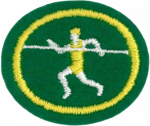Especialidades JA/Pista y campo/Respuestas
| Pista y campo | ||
|---|---|---|
| Asociación General
|
Destreza: 2 Año de introducción: 1978 |
|
Requisitos
|
La especialidad de Pista y campo es un componente de la Maestría Deportista. |
1
2
| Edad | 10 | 11 | 12 | 13 | 14 | 15 | 16 |
| Muchachos | 8.2 | 8.0 | 7.8 | 7.5 | 7.1 | 6.9 | 6.7 |
|---|---|---|---|---|---|---|---|
| Muchachas | 8.5 | 8.4 | 8.2 | 8.1 | 8.0 | 8.1 | 8.3 |
3
4
| Edad | 10 | 11 | 12 | 13 | 14 | 15 | 16 |
| Muchachos | 2'33" | 2'27" | 2'21" | 2'10" | 2'01" | 1'54" | 1'51" |
|---|---|---|---|---|---|---|---|
| Muchachas | 2'48" | 2'49" | 2'49" | 2'52" | 2'46" | 2'46" | 2'49" |
5
5a
24 David estaba sentado entre las dos puertas. El atalaya había ido al terrado sobre la puerta en el muro y, alzando sus ojos, miró y vio a uno que corría solo. 25 El atalaya dio un grito y lo hizo saber al rey, el cual dijo:
—Si viene solo, buenas noticias trae.
Mientras el hombre venía acercándose, 26 vio el atalaya a otro que corría. Dio voces el atalaya al portero diciendo: «Ahí viene otro hombre corriendo solo.»
—También éste es un mensajero —dijo el rey.
27 El atalaya dijo de nuevo:
—Me parece que el primero corre como Ahimaas hijo de Sadoc.
—Ése es hombre de bien y viene con buenas noticias —dijo entonces el rey.
24Do you not know that in a race all the runners run, but only one gets the prize? Run in such a way as to get the prize. 25Everyone who competes in the games goes into strict training. They do it to get a crown that will not last; but we do it to get a crown that will last forever. 26Therefore I do not run like a man running aimlessly; I do not fight like a man beating the air. 27No, I beat my body and make it my slave so that after I have preached to others, I myself will not be disqualified for the prize.
5b
5c
5d
5e
The ball of the foot should touch first.
5f
Your arms should not come across your body. They should be at your side with your hands cupped in a parallel form. Your head should face your direction of travel, straight ahead.
5g
Inhale and exhale in a slow, rhythmic, controlled fashion.
5h
Cross country running often involves hills, while tracks do not. Cross country runners often must contend with traffic, but they are rewarded with changing scenery.
6
6a
6b
See guidance under Requirement #1 for hurdles.
7
In this event the jumpers take turns making a running jump over an increasingly higher bar onto a crash pad. Touching the bar is considered a fault and three consecutive faults ends the jumper's quest. The highest successful jump wins.
The Fosbury Flop was popularized and perfected by American athlete Dick Fosbury first in 1965. His gold medal in the 1968 Summer Olympics brought it to the world's attention. Over the next few years the flop became the dominant style of the event with all elite jumpers using some variation on it. Before Fosbury, most elite jumpers used the straddle technique, Western Roll, Eastern cut-off or even scissors jump to clear the bar. The introduction of deep foam crash pads instead of sandpits or low piles of matting freed high jumpers from the need to land on their feet to prevent injury, and allowed experimentation with the Folsbury Flop coming out the superior technique.
The high jump and pole vault are the two vertical clearance events in the Olympics.
8
This track and field event is now known as the long jump. Successful athletes combine speed, strength, and agility as they try to leap as far as possible from a take off point without crossing over the fault line. The jumper runs down a track (usually crushed rubber) and jumps off a block embedded in the ground into a sand pit. The jump is measured from the block to the nearest point of impact of any part of the body. In competition the best of three jumps is recorded.
The event has a history in the Ancient Olympic Games as the only jumping event and has been a modern Olympic event for men since the first Olympics in 1896 and for women since 1948.
9
9a
9b
These are two different ways to pass the baton. Here is a discussion of how to do each style of handoff. [1]
References
- Categoría: Tiene imagen de insignia
- Adventist Youth Honors Answer Book/Honors/es
- Adventist Youth Honors Answer Book/es
- Adventist Youth Honors Answer Book/Skill Level 2/es
- Categoría: Libro de respuestas de especialidades JA/Especialidades introducidas en 1978
- Adventist Youth Honors Answer Book/General Conference/es
- Adventist Youth Honors Answer Book/Recreation/es
- Adventist Youth Honors Answer Book/Recreation/Primary/es
- Adventist Youth Honors Answer Book/Stage 0/es
- Adventist Youth Honors Answer Book/Sportsman Master Award/es
- Adventist Youth Honors Answer Book

